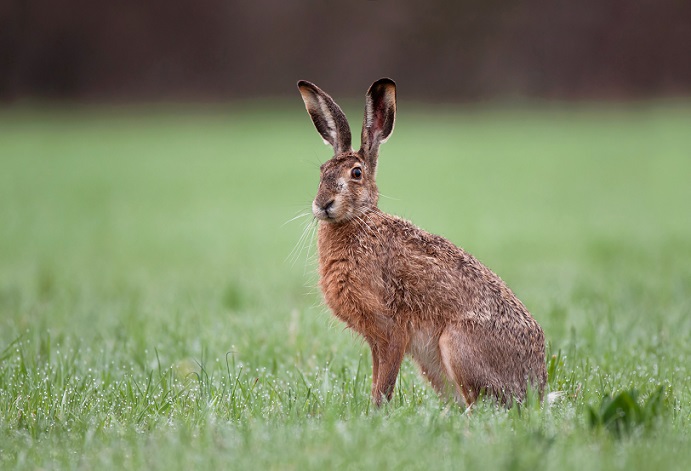
Rabbits and hares belong to the leporidae family of mammals. There are approximately 60 species of rabbit and hare in the leporidae family. Leporids range in mass from 1.4 lbs in pygmy rabbits to 11 lbs in arctic hares. Unlike most mammals, female leporids are usually larger than males. Rabbits and hares can be found throughout the world with very few exceptions. The term ‘true hares’ includes hares and jackrabbits and comprises those species in the genus Lepus; all remaining species are referred to as rabbits. While hares have evolved for running long distances, rabbits run in short bursts and have limbs that are adapted for digging. Hares have long muscled fibers in contrast to the short fibers found in rabbit muscle. Hares are often larger than rabbits.
What do rabbits and hares look like?
Leporids have long hind limbs and feet. Their ears are their most dominant feature also vary in size depending on the species. The colors of their fur range from brown to black to white. Although spots are relatively common in domestic breeds, most wild species have relatively bland coloration that helps them blend in with their surroundings.
Some species that inhabit higher latitudes have white coats during the winter, which are then molted during spring. Rabbits and hares have short bushy tales, which are sometimes conspicuously marked, and the soles of their hind feet are covered with hair. The toes are usually in long, slightly curved claws.Tail length in leporids ranges from 1.5 cm to 12 cm. Rabbits and hares are characterized by their elongated hind limbs and feet and their ears, which can reach 17 cm in the antelope jackrabbit.
Where do rabbits and hares live?
Leporids can be found in most of the world’s landmasses with the exception of southern South America, the West Indies, Madagascar, and most islands southeast of Asia.. Although not native to Australia, or New Zealand, rabbits have been introduced to these locations by humans during the last few centuries.
Habitat
These small mammals can be found in a wide range of environments, from open deserts to boreal forests. Hares and rabbits have distinct habitat requirements. Hares are most often found in an open habitat where they can use their speed to evade potential predators. They also rely on their well-camouflaged fur to hide from predators among the shrubs and rocks.
While hares are most often found in open habitats, rabbits are usually found in habitats with dense cover where they can hide amongst the vegetation or in burrows. Some species of rabbits, such as swamp rabbits and marsh rabbits are excellent swimmers and are considered semi-aquatic.
How do rabbits and hares act?
Some leporids are known to dig burrows or occupy those abandoned by other species. Being hunted is a constant threat in the lives of rabbits and hares and has likely served as a significant selective force in their evolution. Rabbits, which have shorter legs and more compact musculature than hares, are less efficient runners and elude predators by running into holes and burrows. Hares typically travel long distances and have larger home ranges than rabbits, which are usually restricted to the vicinity of their safe havens and have relatively smaller home ranges and territories.
What do rabbits and hares eat?
Leporids are herbivores, with diets consisting of grasses, clovers, and limited amounts of vegetables like broccoli and brussels sprouts. They are opportunistic feeders and also eat fruits, seeds, roots, buds, and the bark of trees. Rabbit and hares also re-ingesting soft green fecal pellets to ensure they get every bit of nutrition from their food source.
